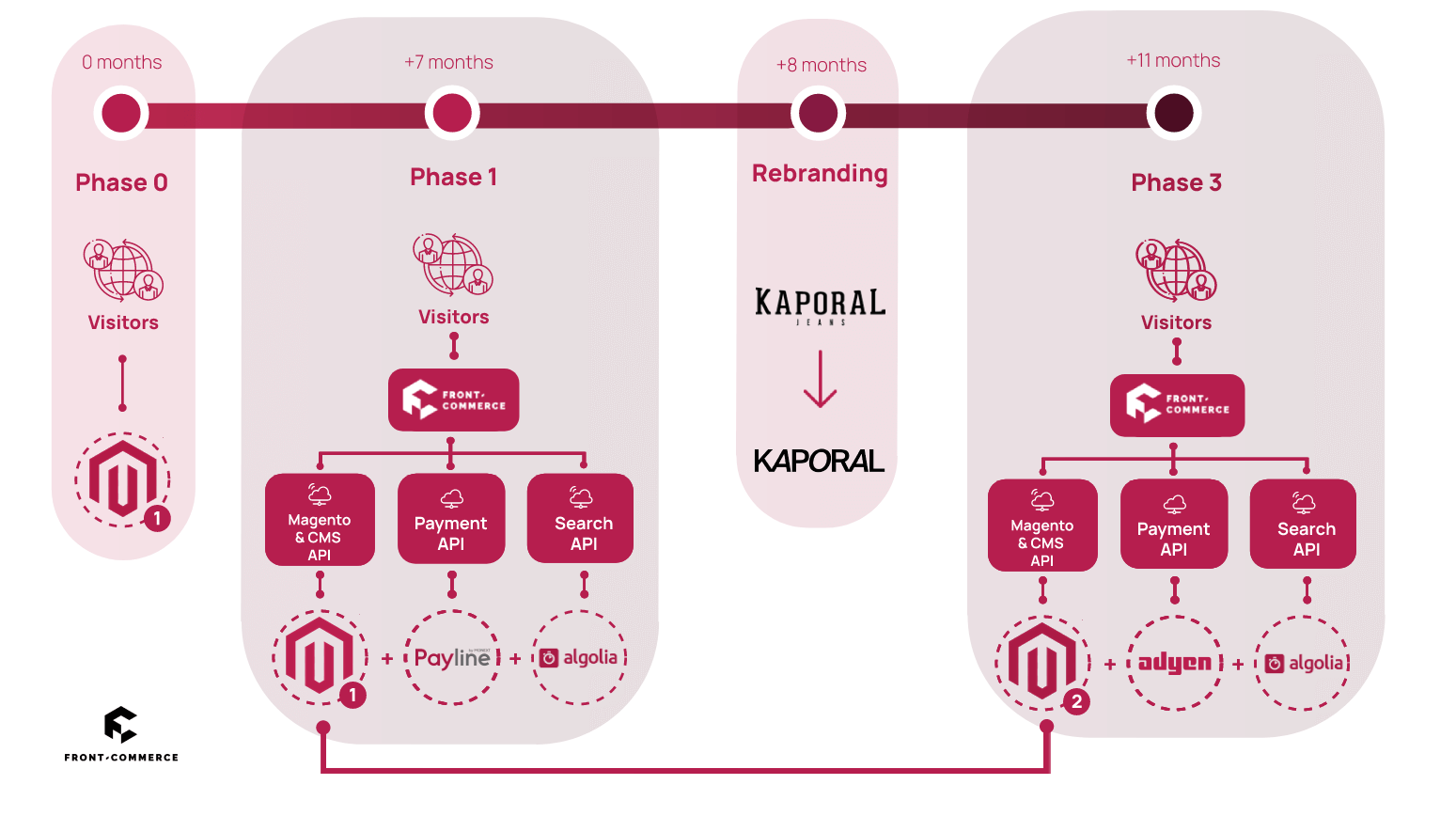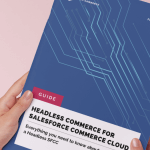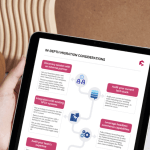Understanding Headless Commerce with Salesforce Commerce Cloud
Choosing the Right Migration Approach
Technical Considerations when migrating to a headless commerce architecture with SFCC
Implementation Roadmap for Headless Commerce with Salesforce Commerce Cloud
Best Practices for Migrating to Headless Commerce with SFCC
Your Roadmap to Headless
The shift towards headless commerce is a significant trend that Salesforce Commerce Cloud (SFCC) users need to understand and prepare for. In acknowledgement, Salesforce has incorporated various features into its platform including a composable storefront, decoupled front-ends, APIs to grant access to SFCC’s commerce functionality, and partnerships with leading headless content management systems such as Contentful and Contentstack.
This article provides a high-level roadmap to help guide SFCC users through the migration to a headless architecture, highlighting the key considerations and benefits. Read on to find out more.
Understanding Headless Commerce with Salesforce Commerce Cloud
Headless commerce is an architectural approach that decouples the front-end (user interface) from the back-end (commerce functionalities), allowing them to be developed, deployed, and scaled independently. This decoupled architecture offers several key benefits for Salesforce Commerce Cloud users including: Flexibility and innovation, faster development cycles and omnichannel experiences.
Embracing Composable Commerce with SFCC
Headless commerce with SFCC also enables the concept of “composable commerce,” where businesses can assemble their e-commerce platform using best-of-breed solutions connected via APIs. This approach future-proofs the platform, allowing for seamless integration with emerging technologies and third-party services, such as content management systems, marketing tools, and payment gateways.
By adopting a headless, composable approach with SFCC, businesses can adapt to evolving customer expectations and technological advancements, ensuring their e-commerce platform remains agile, scalable, and capable of delivering exceptional customer experiences.
Benefits of Pre-configured Storefronts for Salesforce Commerce Cloud
Salesforce Commerce Cloud offers robust back-end functionalities, but its front-end development can be complex and time-consuming. Frontend-as-a-Service (FEaaS) solutions address this challenge by providing pre-configured, composable storefronts. These solutions empower SFCC users to unlock significant benefits:
- Reduced Complexity and Faster Time-to-Market: User-friendly interfaces and pre-built components streamline development, while headless architecture allows independent front-end deployments. This frees developers from SFCC release cycles and accelerates innovation.
- Enhanced Customization and Agility: FEaaS solutions break free from SFCC’s limitations, enabling the creation of unique customer experiences. Open APIs facilitate integrations with best-of-breed marketing and content management tools, while the intuitive interface empowers business users to manage the front-end without extensive coding.
Assessment and Planning
Evaluating your existing e-commerce setup is an important first step in transitioning to a headless commerce architecture. Understanding your current state enables you to align your headless commerce goals with your overall business objectives, ensuring maximum value. This assessment involves identifying key pain points, challenges, and opportunities within your current infrastructure, including:
- The complexity of your product catalog and content management requirements
- The variety of customer touchpoints and devices you need to support
- Scalability or performance issues in your current system
- Limitations in terms of flexibility, agility, and the ability to innovate on the front-end
Identifying Potential ROI
Evaluating potential ROI is crucial to secure buy-in for your headless commerce initiative. Factors to consider include:
- Increased agility and speed-to-market for new features and experiences
- Improved customer engagement and conversion rates through personalization
- Reduced maintenance and development costs
- Enhanced scalability and performance to support business growth
Strategic Planning
Once you have a clear understanding of your current state and the potential benefits, the next step is to develop a comprehensive strategic plan for your headless commerce migration. This plan should include:
- Defining key performance indicators (KPIs) to track the success of your headless implementation, such as customer satisfaction, conversion rates, and time-to-market for new features
- Outlining a phased approach to gradually migrate your e-commerce platform to a headless architecture, starting with high-impact areas and gradually expanding
- Identifying the necessary resources, skills, and organizational changes required to support the migration, including cross-functional alignment and change management
- Establishing a governance framework to manage the ongoing evolution of your headless commerce solution, including processes for evaluating and incorporating new technologies and trends
Choosing the Right Migration Approach
When migrating to headless commerce with Salesforce Commerce Cloud, there are three main implementation strategies to consider, each with its own advantages and considerations.
- Big-bang Replatforming: This involves a complete replacement of SFCC with a new headless commerce solution. While offering flexibility, it comes with higher risks and costs, suitable for those seeking a clean break from legacy systems.
- Progressive Approach: Businesses transition incrementally, migrating specific functionalities or touchpoints while keeping SFCC for other operations. This minimizes disruption and spreads out migration costs.
- Hybrid Approach: Businesses maintain SFCC for backend operations while developing and integrating a new headless front-end. This allows for a seamless transition, leveraging existing SFCC investments while adopting headless commerce benefits.
The big-bang approach is quite complex and has several drawbacks. It is most suitable for larger organizations with well-established development teams and the capacity to handle potential challenges during the migration. A progressive migration approach or a hybrid approach, can be a better fit as it allows for a more manageable transition, reduced risk, and better control over the migration process. But ultimately, the choice will depend on factors such as complexity of the existing e-commerce platform, technical expertise, budget, timeline, and long-term business goals.

E-Commerce replatforming: Big Bang or Progressive Migration?
Technical Considerations when migrating to a headless commerce architecture with SFCC
Transitioning to a headless commerce architecture with Salesforce Commerce Cloud involves several technical considerations that should be addressed to ensure a successful implementation.
1. Compatibility with Existing Systems
Ensuring seamless integration between the headless front-end and the existing SFCC back-end is crucial. This involves evaluating the compatibility of current systems, infrastructure, and data models with the headless approach. Identifying necessary modifications or upgrades to the SFCC platform to support a headless architecture is essential. Additionally, addressing potential data synchronization or migration challenges between the legacy and headless systems is important for a smooth transition.
2. API Integration
Effective utilization of APIs is critical in headless commerce. Businesses should first familiarize themselves with available SFCC APIs to understand implementation capabilities and limitations. Developing a robust API integration strategy, encompassing authentication, authorization, and error handling mechanisms, ensures secure and reliable communication between the front-end and back-end.
3. Data Migration Strategies
The complexity of existing SFCC implementations may necessitate a comprehensive data migration strategy pre-migration. This involves identifying and mapping all relevant data sources, including product catalogs, customer information, and order history. Evaluating data transformation and cleansing requirements ensures data integrity and consistency during migration. Implementing testing and validation procedures guarantees the accuracy and completeness of migrated data.
Implementation Roadmap for Headless Commerce with Salesforce Commerce Cloud
Transitioning to a headless commerce architecture requires a well-structured implementation roadmap. Here’s a step-by-step guide to help teams navigate the process:
1. Assess and Plan
- Evaluate current e-commerce setup (pain points, goals, requirements)
- Develop strategy and plan aligning with business objectives
- Identify KPIs to measure success
- Estimate timeline, resources, and budget
2. Assemble the Team
- Identify a skilled team with expertise in SFCC, headless development, and API integrations
- Ensure cross-functional collaboration
- Provide training and upskilling opportunities
3. Implement the Headless Architecture
- Choose implementation approach (progressive or phased)
- Leverage SFCC’s Composable Storefront and APIs
- Ensure seamless integration (data migration, API integration, compatibility)
- Implement robust testing and validation procedures
4. Launch and Optimize
- Gradual rollout (pilot or phased deployment)
- Monitor performance against KPIs
- Continuously optimize based on feedback and data
- Leverage SFCC’s support and resources
Timeline
The time needed for a successful headless commerce implementation can vary depending on the complexity of your existing e-commerce setup, the scope of the project, and the availability of resources. As a general guideline, migration can take anywhere from 6-12 months, with the potential for a phased rollout to reduce the overall implementation time to as little as 16 weeks.
Best Practices for Migrating to Headless Commerce with SFCC
Ensure a smooth implementation and ongoing optimization with these best practices:
1. Prioritize Security
Protect your commerce data and functionalities by implementing robust API authentication and authorization mechanisms. Follow API security best practices, like OAuth 2.0 and API key management, to mitigate unauthorized access risks. Regularly monitor and audit API usage to detect and address security vulnerabilities.
2. Effective Change Management
Engage cross-functional teams to address organizational and cultural changes. Provide comprehensive training and support to equip employees with the skills needed for the new headless architecture. Establish clear communication channels and feedback loops to address concerns during the transition.
3. Optimize Performance
Deliver a seamless user experience by optimizing your headless storefront’s performance. Leverage progressive web app (PWA) capabilities for fast loading times and offline functionality. Implement caching strategies, such as edge caching and CDNs, to improve response times. Continuously monitor and analyze performance using tools like Lighthouse or PageSpeed Insights to identify and address bottlenecks.
Headless Commerce Migration Success Story
Kaporal’s Migration to a Headless Commerce Architecture
The French clothing company Kaporal sought to enhance their online customer experience and future-proof their e-commerce platform. Facing limitations with their outdated Magento 1 setup, they opted to migrate to a headless commerce architecture with Front-Commerce, followed by transitioning to Magento 2. This strategic move enabled them to leverage a microservices architecture, enhancing website performance and scalability while preparing for future adaptability.
The Migration Process
Kaporal partnered with the web agency Smile to carry out the migration to a headless commerce architecture with Front-Commerce. The key aspects of their migration process include:
- Phased Approach: Kaporal took a phased approach to the migration, gradually transitioning their e-commerce platform rather than a complete “big-bang” overhaul.
- Microservices Architecture: By adopting a microservices architecture, Kaporal was able to migrate functionalities in stages and switch service providers (e.g., payment provider) without disrupting the overall system.
- Improved Time-to-Market: The headless approach allowed Kaporal to divide the cost of migration by 5 and the time-to-market by 4, compared to a traditional re-platforming project.
- Optimized Customer Experience: The migration to Front-Commerce’s headless solution immediately improved Kaporal’s customer experience, particularly on mobile devices.

Results
Kaporal was able to achieve significant improvements in their migration timeline, costs, and customer experience metrics by transitioning to a headless commerce architecture with Front-Commerce.
Pathway to successful headless commerce migration
In conclusion, transitioning to headless commerce with Salesforce Commerce Cloud presents an opportunity for businesses to unlock flexibility, innovation, and scalability in their e-commerce operations. Whether adopting a progressive migration approach or opting for a big-bang overhaul, businesses must prioritize security, effective change management, and performance optimization to ensure a smooth implementation and ongoing success. The success of Kaporal’s migration exemplifies how a strategic phased migration to a headless commerce architecture can yield significant improvements in time-to-market, costs, and customer experience metrics.


